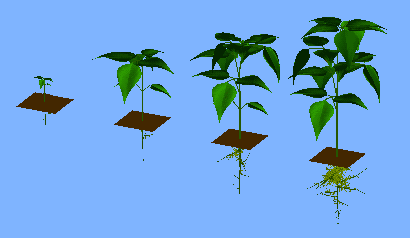
Botany online 1996-2004. No further update, only historical document of botanical science!
click in the picture to get an AVI file, click again to start growth
The development of plants is far more than that of animals regulated by extern signals and factors. A seed, for example, will germinate only under favourable external conditions, i.e. there has to be enough warmth and humidity and day length must have passed a critical value. The seeds of many species from zones with seasonal differences of temperature germinate only after they have gone through a cold period, a phenomenon called stratification. Stratification is not to be confused with vernalization, which means that flower development takes place only after a cold period. All evidence indicates that the seeds contain an inhibitor that is successively degraded during the cold season. Germination occurs exclusively after its degradation. Some species produce the inhibitor anew after periods of long drought and warmth. They do thus pass rhythmic periods of readiness to germinate and quiescence, which allows them to discern between spring and autumn days of the same day length.
Seasonal fluctuations in the ability to germinate of seeds of the species Hyoscyamus niger (henbane, Solanaceae) and Gratiola officinalis (hedge hyssop, Scrophulariaceae). The seeds have been kept under dry and constant conditions. The percentage of germinated seeds was calculated after seven (Hyoscyamus) and fourteen days (Gratiola) in the germinating bed (E. BÜNNING, 1953)

The most important growth-regulating factor is light. Plants are able to discern light of different wave lengths and periods of light or darkness of different lengths.
The degree of plant growth is also dependent on the environment. All physiological and morphological features of a well-tended plant are superior to those of a plant of the same genetic constitution that is provided inadequately. The adaptation to certain environmental parameters is among the most studied topics of botany. The plant reacts always to a whole complex of factors whose single components have either an additive or a multiplicative effect on the plant's growth. Just like the development of every other multi-cellular organism requires that of a plant a specialization of its cells, an optimal supply and a sufficient flow of information between the cells. The information system of plants is by far inferior to that of animals. No as effective system as circulation, for example exists for the distribution of molecules and cells. Neither do plants have a nervous system. They do have hormones, however.
Animals are characterized by allometric growth, which means that their increase in size is caused by the proportional growth of all body parts, i.e. during growth exist dividing cells in all tissues. In addition follows the development of animals a temporally fixed course, while that of plants can be arbitrarily interrupted. Its developmental pace remains variable.
Plants grow by apical growth, which means that usually only the cells of the meristems at the periphery of the body of vegetation divide. All other cells are in a state of quiescence. They keep their ability to divide and can reactivate it if necessary (a condition called totipotency). The species-specific shape of plants shows that the activities of the single growing points are tuned during growth (apical dominance). We know a number of the rules that determine growth and differentiation processes. The development of polarity is a very important factor, just like gradients of activating or inhibiting substances. The top-bottom polarity determines the plant's axis. Very specific patterns develop due to gradients of morphogenic substances. Among them is the alternate or opposite position of lateral shoots or leaves, the regular distribution of guard cells or hairs at the leaf surface and the time of flower formation.
© Peter v. Sengbusch - Impressum